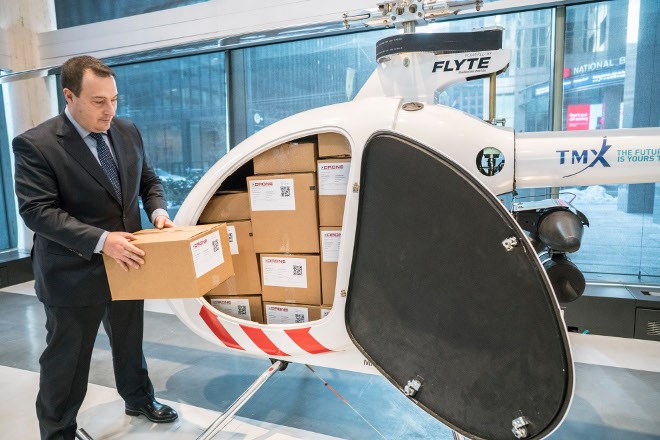Drone Delivery Canada (DDC) has launched its newest cargo drone, the Condor, which is capable of carrying 400 pounds of payload and travelling 200 kilometres.
Unveiled to the public in Toronto on Feb. 19, the Condor has a wing span of about 20 feet and is powered by a gas propulsion engine.
Tony Di Benedetto, CEO at Vaughan, Ont.-based DDC, said that allows the drone to fly farther, carry bigger payloads, and withstand more severe weather.
“The other models are all electric; they’re powered by lithium battery technology,” he said. “To achieve bigger capacities, bigger distances, we need a different type of propulsion system, and this is a very small engine. It’s just a very efficient design.”
Since its inception in 2014, DDC’s main objective has been to develop drones that can deliver essential items to Canada’s remote and Indigenous communities more efficiently and at reduced cost than through standard transportation methods.
Its drones are outfitted with the company’s proprietary FLYTE management software, a system that works with any model of drone.
The earliest model, the Sparrow, can carry 10 pounds of cargo and fly just a few kilometres. DDC followed that up with the Raven, which can carry 25 pounds of payload and fly 60 kilometres, and the Falcon, which can carry 50 pounds of cargo and fly 60 kilometres.
Over time, demand has grown for larger cargo drones that can deliver things like food, medical supplies and bulky items to remote communities, Di Benedetto said, and the technology has now advanced to the point that the drones can transport either static or tethered cargo.
For the next iteration, he noted, DDC is looking at more than tripling the Condor’s current capacity.
“We went from 10 pounds to 25 pounds to 50 pounds, and now we're going to 400. It’s this momentum to keep pushing this envelope forward,” he said. “And we're not stopping at the Condor. The next reiteration, we’ll probably do about 1,500 pounds.”
The company will work with Transport Canada to meet its flight protocols, and, if all goes well, will start testing the Condor in the third quarter of 2019.
That’s also around the time that the company’s new, 16,000-square-foot operations centre should be up and running, Di Benedetto said.
Announced in early February, the Vaughan-based facility will have room for up to 25 drone operators and function like an air traffic control centre, from which DDC can monitor the drones’ flight paths. The facility will also be able to accommodate the company’s research and development team, along with space for its bigger drones, Di Benedetto noted.
“This is the first of several mission control centres that we’re going to be setting up in the near future, and this is really essential because, without this, we can’t commence operating commercially,” he said.
Some staff are already in place, but filling out the ranks will be the responsibility of Michael Zahra, who DDC hired in January as its senior vice-president of operations and strategy. Zahra is the former president of Staples Business Advantage Canada and the former president of Yahoo! Canada.
Also in January, the company announced its intention to pursue $12 million in funding through Transport Canada’s National Trade Corridors Fund, which aims to improve transportation infrastructure in Canada’s Northern territories.
“These communities all have access to a tremendous amount of funding from the federal government for infrastructure solutions, and the way we see our technology, it is an infrastructure play,” Di Benedetto said. “So where we can deploy our technology very quickly it becomes very scalable.”
DDC established a model for successful commercial operations last December after signing a $2.5-million commercial agreement with Moose Cree First Nation to deploy its technology in that territory.
Using its Sparrow drone, DDC ran a series of beyond-visual-line-of-sight tests, successfully flying medical supplies, mail and other parcels between the James Bay communities of Moosonee and Moose Factory.
Commercial operations are expected to begin there at the start of the third quarter of this year, said Di Benedetto, adding the company is in discussions with about 50 additional Northern communities which have expressed interest in the technology.
With 1,000 remote Indigenous communities across Canada, he believes DDC’s technology has even wider applications, and he welcomes inquiries from anyone interested in starting a discussion about the possibilities for the drone delivery system.
“I think it’s a great success story for Canada,” Di Benedetto said. “Really, we’re leaders in the world, I think, for this technology.”




